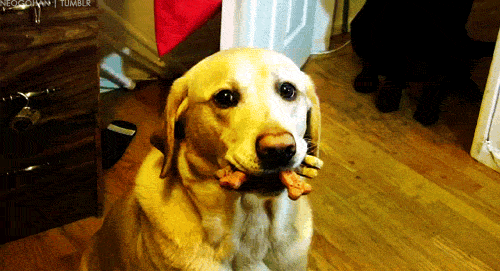
The Great Pyrenees is so cool so why don't you have a look at some facts about them!
#1. "The Great
Pyrenees is also known as the Pyrenean Mountain Dog."
#2. "The length of the dog is slightly longer than it is tall."
#3. "The head is wedge-shaped with a slightly rounded crown and is in proportion to the rest of the body."
#4. "The back line is level."
#5. "The skull is

as wide as it is tall with flat cheeks. There is no apparent stop."
#6. "The nose an
d lips are black."#7. "The teeth meet in a scissors or level bite."
#8. "The dark brown, medium sized eyes are almond shaped and slanted."
#9. "The dark brown, V-shaped ears are carried low, flat and close to the head, rounded at the tips, set about eye level."

#10. "The chest is fairly broad."
#11. "The well feathered tail reaches the hocks and can be carried low, or up over the back in a wheel when the dog is excited. There is sometimes a crook at the end of the tail."
#12. "The dog has a weather-resistant double coat. The undercoat is dense, fine and wooly, and the outer coat is long, thick, coarse and flat. There is a mane around the shoulders and neck which is more apparent in male dogs. There is feathering on the tail and along the back of the legs. Coat is either solid white or white with patches of tan, wolf-gray, reddish-brown or pale yellow."
#13. "The Great Pyrenees is a capable and imposing guardian, devoted to its family, and somewhat wary of strangers - human or canine."
#14. "They are often used to guard livestock."
#15. "When not provoked, it is calm, well- mannered, and somewhat serious."
#16. "Courageous, very loyal and obedient."
#17. "Gentle and affectionate with those it loves."
#18. "Devoted to family even if self-sacrifice is required."
#19. "It is very gentle with its family and children. It does best with children when it is raised with them from puppyhood, and if they are not being used as working flock guards be sure to socialize them well with people, place and noises."
#20. "It has an independent nature, and may try to dominate a less secure or meek owner, and/or an owner who treats the dog as if it is human, becoming stubborn or territorial."
#21. "Owners need to be firm, but calm, confident and consistent with the dog. Setting rules the dog must follow and sticking to them."
#22. "A serious worker, but very independent."
#23. "Be patient when training the Great Pyrenees, as it may be slightly difficult."
#24. "If left alone inside the home without the proper amount of exercise and or leadership they can become destructive."
#25. "The Great Pyrenees is good with non-canine animals, and usually loves cats."
#26. "These dogs do not reach maturity until they are about 2 years old."
#27. "Some are not good off the leash and may wander away."
#28. "Needs an owner who understands and practices natural dogmanship."
#29. "The Great Pyrenees tend to bark a lot and some tend to drool and slobber."
#30. "Height: Dogs: 27-32 inches (69-81cm.)
Bitches: 25-29 inches (63-74cm.)
These are the average heights, but some Pyrenees are as much as 40 inches (1 meter.)"
#31. "Weight: Dogs: from 100 pounds (45kg.)
Bitches from 85 pounds (38kg.)"
#32. "Prone to bloat, hip dysplasia, bone cancer, luxated patellas. Can develop skin problems in very hot weather."
#33. "These dogs are not recommended for apartment life and would do best with a mid-to-large sized yard. They need space, but adapt well to family life. They are not really active indoors, but need regular exercise outdoors. A fence is a must as they may wander away in search of the boarders to what they believe is their territory. Puppies are very active and might have the tendency to wander off or escape. Prefers cool climates."
#34. "Pyrenees need plenty of exercise to stay in shape. If they are not actively working as a flock guardian, they need to be taken on a daily, long brisk walk."
#35. "Life Expectancy: About 10 years."
#36. "Regular brushing of the long double coat will keep it in good condition, but extra care is needed when the dog is shedding its dense undercoat. The outer coat does not mat unless there is a burr, foxtail or some other outside object that gets stuck to the coat. This can be an issue for outside working dogs. Some owners choose to shave the coats in the summer to avoid this from happening, but beware of sunburn. Bathe or dry shampoo only when necessary. Great Pys shed all year round but does so heavily once a year."
#37. "The Great Pyrenees originated in Central Asia or Siberia. The breed was descended from the Hungarian Kuvasz and the Maremmano-Abruzzese. The Pyrenees is also a relative of the St. Bernard, contributing to their development. It has a long history as a guard dog of sheep. The dogs made their way to Europe, the Great Pyrenees remained in the high mountain regions until the Middle ages, When the breed gradually gained popularity with the French nobility as a guard dog. By the late 17th century, every French noble wanted to own one. Armed with a spiky collar and thick coat, the Great Pyrenees protected vulnerable flocks from such predators as wolves and bear. The Great Pyrenees has proven to be a very versatile breed working as an avalanche rescue dog, as a cart-puller, sled dog, as a pack dog on ski trips, a flock guardian, dog of war, and as a companion and defender of family and property. The AKC officially recognized the Great Pyrenees in 1933."
Info from: http://www.dogbreedinfo.com/greatpyrenees.htm
Pic of adult and puppies from: http://www.dogbreedinfo.com/greatpyrenees.htm
Pic of puppy from: http://www.cutepuppiesforsale.net/great-pyrenees-dog-breed/




No comments:
Post a Comment